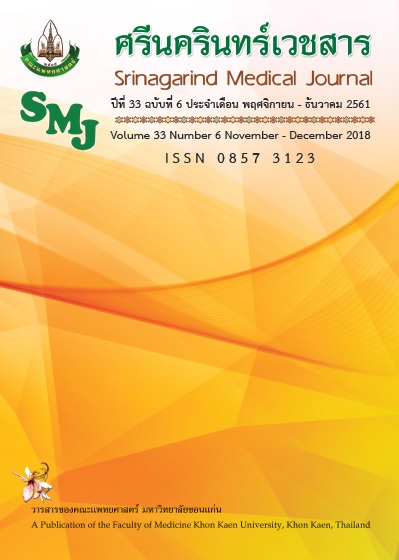การเปรียบเทียบผลการควบคุมระดับน้ำตาลในผู้ป่วยโรคเบาหวานชนิดที่ 2 ตามเป้าหมายการรักษา 2 รูปแบบ
คำสำคัญ:
เป้าหมายการรักษาโรคเบาหวาน; การติดตามผล; ระดับน้ำตาลบทคัดย่อ
หลักการและวัตถุประสงค์: ปัจจุบันประเทศไทยมีเป้าหมายการรักษาโรคเบาหวาน 2 รูปแบบ คือ ตามสำนักโรคไม่ติดต่อ (แบบที่ 1) เป็นเป้าหมายเดียวสำหรับผู้ป่วยทุกรายและใช้ในโรงพยาบาลส่วนใหญ่ อีกแบบคือแนวทางเวชปฏิบัติสำหรับโรคเบาหวาน พ.ศ. 2557 (แบบที่ 2) ซึ่งปรับให้เหมาะกับผู้ป่วยเฉพาะราย ดังนั้นการศึกษาจึงมีวัตถุประสงค์เพื่อเปรียบเทียบผลการควบคุมน้ำตาลตามเป้าหมาย 2 รูปแบบและความถี่ของการเกิดภาวะน้ำตาลในเลือดต่ำ
วิธีการศึกษา: เก็บข้อมูลระดับน้ำตาลในเลือด (FBS) ระดับน้ำตาลในเลือดสะสม (HbA1c) และการเกิดภาวะน้ำตาลในเลือดต่ำแบบไปข้างหน้า ในผู้ป่วยโรคเบาหวานชนิดที่ 2 ที่โรงพยาบาลจัตุรัส ในช่วงระหว่างวันที่ 1 มิถุนายน 2559 – 31 มีนาคม 2560 (10 เดือน) จากฐานข้อมูลอิเล็กทรอนิกส์ (HOSxP) ของโรงพยาบาลและการสัมภาษณ์ผู้ป่วย
ผลการศึกษา: ผู้ป่วย 153 ราย ร้อยละ 79.1 เป็นหญิง อายุเฉลี่ย 60.65 ± 9.77 ปี ตามเป้าหมายแบบที่ 1 ผลการควบคุม FBS รายครั้งและรายบุคคลได้ร้อยละ 32.5 และ 13.1 การควบคุม HbA1c ได้ร้อยละ 37.9 และ 22.9 ตามลำดับ ส่วนเป้าหมายแบบที่ 2 ผลการควบคุม FBS รายครั้งและรายบุคคลได้ร้อยละ 44.2 และ 22.2 การควบคุม HbA1c ได้ร้อยละ 53.9 และ 45.8 ตามลำดับ พบผู้ป่วย 49 ราย (ร้อยละ 32.0) เกิดภาวะน้ำตาลในเลือดต่ำ โดย 43 ราย (ร้อยละ 87.8) ควรถูกกำหนดเป้าหมายการควบคุมแบบไม่เข้มงวด
สรุป: การควบคุมระดับน้ำตาลตามเป้าหมายแบบที่ 1 มีผลให้ผู้ป่วยควบคุมระดับน้ำตาลได้น้อยกว่าแบบที่ 2
เอกสารอ้างอิง
2. Centers for disease control and prevention. National Diabetes Statistics Report 2017. [Internet] 2017 [cited May 28, 2017]. Available from: https://www.cdc.gov/diabetes/pdfs/data/statistics/national-diabetes-statistics-report.pdf
3. วิชัย เอกพลากร, หทัยชนก พรรคเจริญ, กนิษฐา ไทยกล้า, วราภรณ์ เสถียรนพเก้า. การสำรวจสุขภาพประชาชนไทยโดยการตรวจร่างกาย ครั้งที่ 5 พ.ศ.2557. กรุงเทพฯ : สำนักพิมพ์อักษร กราฟฟิก แอนดีไซต์ ; 2559.
4. International diabetes federation. Managing older people with type 2 diabetes global guideline. [Internet] 2013 [cited August 31, 2015]. Available from: file:///C:/Users/JOOBJANG1/Downloads/english-6th%20(1).pdf
5. American Diabetes Association. Standard of medical care in diabetes-2017. Diabetes care 2017;40 (Suppl 1): S48-S56.
6. The Action to Control Cardiovascular Risk in Diabetes Study Group, Gerstein HC, Miller ME, Byington RP, Goff DC, Bigger JT, Buse JB, et al. Effects of Intensive Glucose Lowering in Type 2 Diabetes. NEJM 2008 ;358:2545-59.
7. สมาคมโรคเบาหวานแห่งประเทศไทย. แนวทางเวชปฏิบัติสำหรับโรคเบาหวาน พ.ศ. 2557. พิมพ์ครั้งที่ 1. กรุงเทพมหานคร:อรุณการพิมพ์; 2557.
8. กระทรวงสาธารณสุข. ระบบข้อมูลตัวชี้วัดสำคัญ (Key performance indicator). [Internet] 2015 [cited June 21, 2017]. Available from: http://healthdata.moph.go.th/kpi/2557/KpiDetail.php?topic_id=39
9. คลินิกโรคเบาหวาน โรงพยาบาลจัตุรัส จังหวัดชัยภูมิ. รายงานประปีงบประมาณ 2558 คลินิกโรคเบาหวาน โรงพยาบาลจัตุรัส จังหวัดชัยภูมิ, 2558.
10. สำนักงานสาธารณสุข จังหวัดชัยภูมิ. ร้อยละผู้ป่วยนอกโรคเบาหวาน ที่มารับบริการใน ศสม. และรพ.สต. มีผลการควบคุมโรคเบาหวาน ตามเกณฑ์ ปีงบประมาณ 2558. [Internet] 2015 [cited August 13, 2015]. Available from: http://203.157.102.136/hdc/main/index.php?sele_kpiyear=2015&level=3&sele_kpi=848b5045eab655b7be0069efcc445dd9
11. Fox KM, Gerber Pharmd RA, Bolinder B, Chen J, Kumar S. Prevalence of inadequate glycemic control among patients with type 2 diabetes in the United Kingdom general practice research database: A series of retrospective analyses of data from 1998 through 2002. Clin Ther 2006; 28: 388-95.
12. Mendes AB, Fittipaldi JA, Neves RC, Chacra AR, Moreira ED Jr. Prevalence and correlates of inadequate glycaemic control: results from a nationwide survey in 6,671 adults with diabetes in Brazil. Acta Diabetol 2010; 47: 137-45.
13. กรรณิกา ปัญญาภู,รัตนาภรณ์ อาวิพันธ์, ชบาไพร โพธิ์สุยะ, ชิดชนก เรือนก้อน. ประสิทธิผลและบทบาทของเภสัชกรในทีมสหสาขาวิชาชีพในการดูแลผู้ป่วยโรคเบาหวานชนิดที่ 2 ณ หอผู้ป่วย. วารสารเภสัชกรรมโรงพยาบาล 2551; 18: 241-51.
14. อรวรรณ โพธิ์เสนา, สุภาวดี ศรีชารี, นารี เต็มแบบ, กานต์ชนก ดอนโชติ, พราวอเคื้อ โหม่งพุฒ. ผลลัพภ์การบริบาลทางเภสัชกรรมในผู้ป่วยโรคเบาหวานและความดันโลหิตสูงโดยเภสัชกรโรงพยาบาลส่งเสริมสุขภาพตำบล. วารสารเภสัชกรรมโรงพยาบาล 2555; 22: 106-14.




